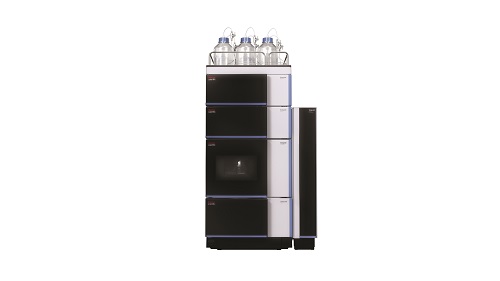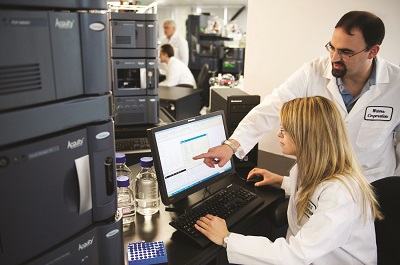Featured Article

The need for speed and flexibility cannot be denied in separating liquids
In many realms of science and applied technology, the first step in a process takes things apart. Doing that can involve breaking down information or physically separating things. Many scientists use liquid chromatography (LC) to separate solutions into components that can be analyzed with other technologies, often mass spectrometry (MS). From LC, the technology advanced to high-performance LC (HPLC) and then to ultra-HPLC (UHPLC or UPLC). Despite being the newest form of LC, UHPLC platforms come in many forms.
“Over 10 years ago, the first UHPLC system with the respective column technology was commercialized,” says Carsten Paul, HPLC product marketing manager at Thermo Fisher Scientific (Waltham, MA). “The use of these sub-2-micrometer particle columns and UHPLC systems with reduced dead volumes and increased backpressure capabilities enabled chromatographers to significantly speed up an HPLC assay.”
As much as any other metric in modern analytical equipment, speed plays a fundamental role. Although “big data”’ is a big deal these days—maybe the most popular buzz phrase in science for the past few years—scientists and manufacturers have searched for ways to speed up technologies since the start of science, and LC is no exception. Despite all of the improvements in LC speed, says Paul, “in several cases the throughput gains are sometimes not enough, even with UHPLC technology instead of HPLC technology.” Sometimes, there was just no easy way to speed up an application. On top of the speed still being less than desired, changing an existing HPLC application to a UHPLC application requires some work in method development and validation.
Those needs push manufacturers to produce platforms that do more. “The new Thermo Scientific Vanquish Duo UHPLC system for Dual LC tackles all these problems,” Paul claims. “The instrument uses a Vanquish Dual Split Sampler, which consists of two separated injection devices including two needles, two loops, and two valves.” By using two pumps—for example, the integrated dual gradient pump—and two detectors of any kind, Paul points out, “this single system can double the capability of any other UHPLC system.”
 Some platforms, like the Thermo Scientific Vanquish Duo UHPLC system, can easily be used in more than one workflow. (Image courtesy of Thermo Fisher Scientific.)
Some platforms, like the Thermo Scientific Vanquish Duo UHPLC system, can easily be used in more than one workflow. (Image courtesy of Thermo Fisher Scientific.)In addition to Thermo Fisher Scientific’s new system, scientists can explore many others (see https://www.labcompare.com/Laboratory-Analytical-Instruments/1402-Ultra-High-Performance-Liquid-Chromatograph-UHPLC/.) Here, a handful of UHPLC features and platforms will be explored, but visit the Labcompare link for more details and devices.
Particles and pressures
Two of the key metrics in UHPLC are the size of the particles in the columns and the pressure used to push through a liquid sample. To be UHPLC, columns include porous particles that are less than 2 micrometers in diameter—mostly 1.8. Compared to columns using 5-micrometer particles, the ability to pull apart samples really goes up. In addition, UHPLC platforms push the liquids with high pressures—thousands of pounds per square inch. These features and others make UHPLC 10 times faster than its predecessors.
Combining better resolving power and faster speeds explains much of the wide adoption of UHPLC. This separating technology is often used in basic research, plus clinical, food, and pharmaceutical industries. Part of the diversity of applications reflects the variety of potential detectors, from fluorescence and UV/VIS to refractive index and tandem MS.
Beyond the basic expectations of smaller particles and higher pressure, advanced UHPLC platforms should include many other features. “The Vanquish Duo UHPLC system for Dual LC makes best use of the existing resources such as bench space and budget,” Paul says. “With this single system, the throughput of any application can be simply doubled, whether it’s a validated HPLC method, a fast UHPLC method, or an isocratic size-exclusion chromatography method.”
Even when saving space and money, scientists can expect this UHPLC platform to provide even more. “Complex samples, such as those common in the biopharma industry, often require the analysis of one specific sample with multiple separation mechanisms, such as size-exclusion and ion-exclusion chromatography,” Paul explains. “This can now be done simultaneously in one single instrument.”
Modes and methods
When asked about the latest UHPLC system from Waters (Milford, MA), Eric Grumbach—director, product marketing for chromatography systems—says, “Waters introduced several innovative LC systems in the first half of 2018 including our ACQUITY Arc Bio System as well as the ACQUITY UPLC PLUS Series, which consists of three family members: the ACQUITY UPLC H-Class PLUS, H-Class PLUS Bio, and I-Class PLUS.”
 The ACQUITY UPLC platforms come in versions that meet a range of separation and analytical needs. (Image courtesy of Waters.)
The ACQUITY UPLC platforms come in versions that meet a range of separation and analytical needs. (Image courtesy of Waters.)The ACQUITY Arc Bio System is an LC platform that works well for late-stage development and routine analysis of biopharmaceuticals. “The primary differentiation of this platform is Arc Multi-Flowpath technology, a novel selectable dwell volume feature that enables seamless method transfer from legacy LC instrumentation and larger HPLC particles, with the flexibility to also utilize modernized smaller particle column technology to improve sample characterization and the throughput of the analysis,” Grumbach explains.
In 2004, Waters was the first to market with a UPLC system and 1.7-micron BEH (Ethylene Bridged Hybrid) column particle. Since then, the company has continually expanded and improved its UPLC offerings. The three new additions to its ACQUITY UPLC platform, the ACQUITY UPLC PLUS Series, “are ideal inlets to mass spectrometry,” says Grumbach. Each system, though, provides specific features and benefits. For example, Grumbach says, “The ACQUITY UPLC H-Class PLUS Bio System minimizes undesirable protein interactions and maximizes system robustness under high salt conditions, enabling the flexibility and robustness to run all chromatographic modes required to characterize complex biopharmaceuticals.”
As scientists move ahead with newer methods of LC, that doesn’t always mean that older methods get left behind. Instead of bringing all methods ahead to UHPLC, some might work just fine with HPLC. Plus, when a scientist or company has a method validated on HPLC, it might be easier to keep it that way. Nonetheless, the same lab might like to explore UHPLC for other applications. Instead of purchasing two platforms, some devices run HPLC and UHPLC. For instance, scientists can use the Shimadzu (Tokyo, Japan) Nexera HPLC/UHPLC Method Scouting System. As Shimadzu notes: “Method scouting is a process where different mobile phases and column stationary phases are evaluated to determine the best set of separation conditions for a particular sample.” With the potential to compare 16 solvents in six different columns, this platform can compare as many as 96 separation conditions for a sample. “The Nexera Method Scouting Solution software has intuitive, user-friendly screens to set the pump and column valve positions, gradient program steps, and it automatically builds the sequence table in seconds,” the company notes. In addition, Shimadzu offers dedicated UHPLC platforms.
With so many samples, many of them extremely complex, scientists need a range of options for separating out components for analysis. Sometimes, the key is dividing samples more completely; in other situations, the samples need to be processed faster. Whatever it takes, today’s UHPLC market more than likely provides a suitable solution. But, don’t expect the advances in the market to slow down. The need for speed in UHPLC cannot be stopped.
Mike May is a freelance writer and editor living in Texas. He can be reached at [email protected]